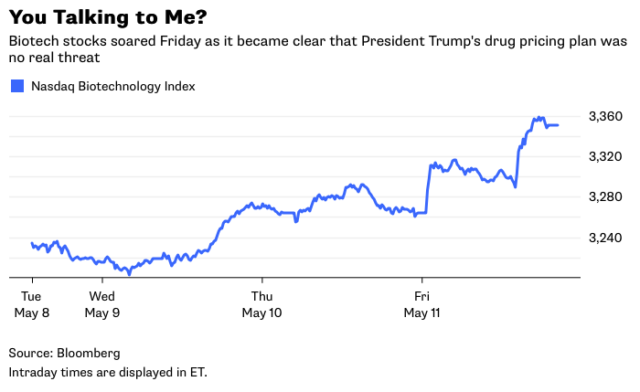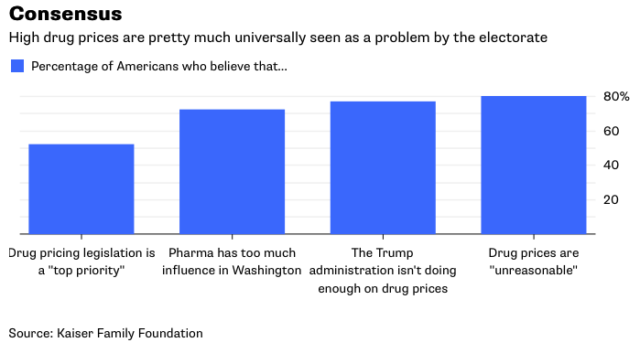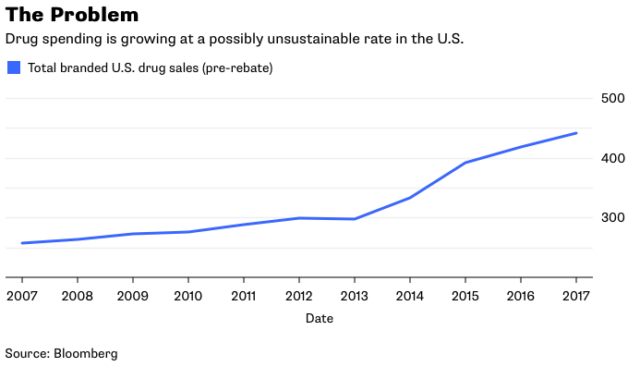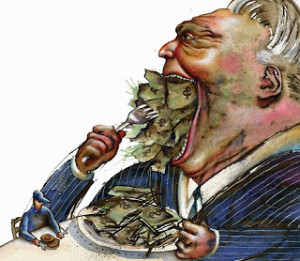Until we are willing to accept the trade-offs and sacrifices needed to fix the system, the status quo will persist.
 The idea of bringing down U.S. drug prices is universally popular. The hard choices, trade-offs and political fortitude needed to actually do it, however, are a harder sell. So here we are, with a drug-pricing plan so toothless that biotech shares soared as it was unveiled by President Donald Trump (recently).
The idea of bringing down U.S. drug prices is universally popular. The hard choices, trade-offs and political fortitude needed to actually do it, however, are a harder sell. So here we are, with a drug-pricing plan so toothless that biotech shares soared as it was unveiled by President Donald Trump (recently).
 No one likes the thought of life-saving medicines with price tags of tens of thousands of dollars or more. But the fact is, Americans have come to expect unfettered access to an ever-expanding roster of effective medicines, without having to pay a lot for it. The current system enables this through generous tax-exempt employer health coverage, Medicare, and programs from drugmakers that help with out-of-pocket expenses.
No one likes the thought of life-saving medicines with price tags of tens of thousands of dollars or more. But the fact is, Americans have come to expect unfettered access to an ever-expanding roster of effective medicines, without having to pay a lot for it. The current system enables this through generous tax-exempt employer health coverage, Medicare, and programs from drugmakers that help with out-of-pocket expenses.
To mess with that extremely expensive expectation is to play with fire. But the reality is that effective drug-pricing interventions tend to involve politically unpopular sacrifice. So instead we get watered-down policy that doesn’t ask too much of us or the system.
 President Trump’s drug-pricing plan is a perfect example. He called it “the most sweeping action in history on drug prices,” and that may be true, but if so, that’s not a good thing — it’s an indictment of past inaction. Either way, there is little in his plan that is likely to be make a big difference in the near term.
President Trump’s drug-pricing plan is a perfect example. He called it “the most sweeping action in history on drug prices,” and that may be true, but if so, that’s not a good thing — it’s an indictment of past inaction. Either way, there is little in his plan that is likely to be make a big difference in the near term.
Some of Trump’s initiatives will be only mildly impactful, like changes to the Medicare Part D drug benefit that might slightly lower costs to the government and seniors. Other proposals are vague and may never be pursued, like changes to the drug-rebate system. Still others are nonsensical political theater, like the notion that other countries can be compelled to raise drug prices, and that this will somehow lower U.S. prices.
The few immediate actions outlined in the plan — like ending a rule that makes it hard for pharmacists to steer patients to lower-priced options and forcing drugmakers to include the list price of drugs in advertisements — will be visible in a campaign year and allow the administration to claim it is taking action. But they won’t actually stop soaring drug spending.
 Trump’s plan could have had more teeth if he followed through on a policy he once endorsed, and has been criticized for not pursuing: allowing Medicare to directly negotiate drug prices. But here again is another example where trade-offs would be required. Nine out of 10 Americans are in favor of giving the government the power to negotiate, according to a Kaiser poll. But that number would drop precipitously if they knew what the government would have to do in order to make the policy effective.
Trump’s plan could have had more teeth if he followed through on a policy he once endorsed, and has been criticized for not pursuing: allowing Medicare to directly negotiate drug prices. But here again is another example where trade-offs would be required. Nine out of 10 Americans are in favor of giving the government the power to negotiate, according to a Kaiser poll. But that number would drop precipitously if they knew what the government would have to do in order to make the policy effective.

graphic: Bull’s Eye/Imagezoo/Getty Images
To gain any leverage with drugmakers, the government would need to be able to refuse Medicare coverage of certain medications because they are too expensive, and firmly steer patients to cheaper treatments. That is, the more restrictive the government is allowed to be, the bigger the potential impact on prices. But enacting such restrictions would be enormously unpopular. It’s one thing when it’s a private company making you jump through hoops, it’s another entirely when Uncle Sam is telling your grandmother she can’t have a potentially lifesaving medicine.
An extremely mild version of this policy — requiring people to pay a higher portion of a drug’s cost if they pick a more expensive option over a cheaper alternative — got only 51 percent approval in a Kaiser poll, which kind of says it all.
Americans’ expectations and political reality are far from the only problems. At the end of the day, it’s drugmakers that take advantage of the country’s fragmented system and lax regulation to set extremely high prices. But until politicians — and let’s face it, their constituents — are willing to acknowledge and grapple with these trade-offs, drug pricing rhetoric will continue to be fiery, but policy will be milquetoast.
Written by Max Nisen and published by Bloomberg ~ May 13, 2018.

Show me de monee!
FAIR USE NOTICE: This site contains copyrighted material the use of which has not always been specifically authorized by the copyright owner. We are making such material available in our efforts to advance understanding of environmental, political, human rights, economic, democracy, scientific, and social justice issues, etc. We believe this constitutes a ‘fair use’ of any such copyrighted material as provided for in section 107 of the US Copyright Law. In accordance with Title 17 U. S. C. Section 107, the material on this site is distributed without profit to those who have expressed a prior interest in receiving the included information for research and educational purposes. For more information go to: http://www.law.cornell.edu/uscode/17/107.shtml“
